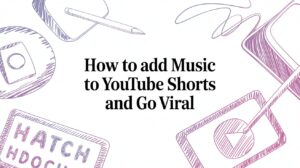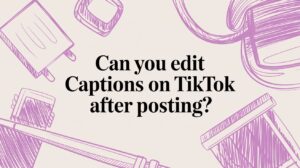As of 2024, an Instagram Reel can technically be up to three minutes long. But let's be real—just because you can use all that time doesn't mean you should. The sweet spot for top-performing Reels is often a much snappier 15 to 30 seconds, perfect for grabbing the fleeting attention of today's audiences.
The Evolving Length of Instagram Reels
Ever scroll through your feed and see a quick, punchy 15-second meme followed by a three-minute mini-documentary? There's a reason for that variety. The evolution of Reel length wasn't random; it was Instagram's strategic answer to shifting user habits and fierce competition from platforms like TikTok, which mastered the art of bite-sized video.
Instagram's journey from a tight time limit to today's more flexible duration shows how they've been trying to give creators more room to play while keeping users glued to the app.
From 15 Seconds to 3 Minutes
When Reels first dropped, they came with a strict 15-second time limit. This forced creators to get their point across fast, packing a ton of creativity into a tiny package. But as creators got more ambitious and audiences wanted a bit more substance, Instagram started loosening the reins.
First, the cap was doubled to 30 seconds. Then it jumped to 60 seconds, and later to 90 seconds. Finally, it landed at the current three-minute maximum. This gradual increase shows Instagram adapting to what creators were asking for—more creative freedom—while also trying to keep pace with rivals allowing longer videos. You can dig deeper into this timeline over at Metricool.com.
This infographic gives you a great visual of how the time limit has expanded over the years.
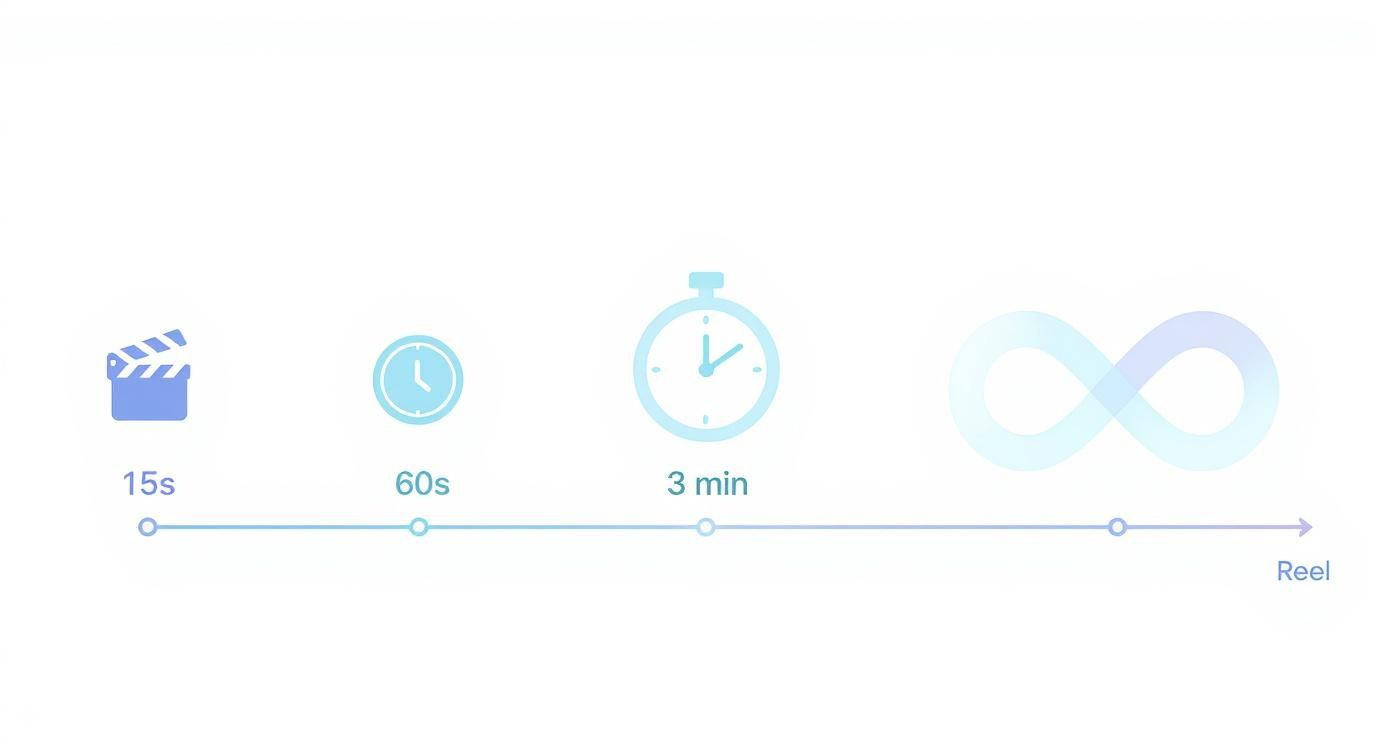
As you can see, the trend has clearly been about giving creators more runway, shifting from quick content bursts to opportunities for more detailed storytelling.
Why This Evolution Matters for Your Strategy
So, why does this history lesson matter? Because it gets to the heart of the constant battle between what's possible and what's effective. Sure, you can post a three-minute tutorial, but the Instagram algorithm still loves content that people watch all the way through.
A viewer is far more likely to finish a 15-second clip than a three-minute one. A high completion rate tells the algorithm your content is engaging and deserves to be pushed out to a wider audience.
Practical Example: A Food Blogger's Journey
A food blogger who started with 15-second "recipe reveal" Reels could later use the 90-second limit to show a single, crucial step, like how to perfectly fold a dumpling. Now, with three minutes, they can walk viewers through the entire recipe in one condensed video.
This flexibility is a massive advantage. The key isn't to aim for the maximum time limit every time. Instead, think of the different lengths as tools in your creative toolkit. Knowing how long Reels can be is one thing; knowing how long they should be to hit your goals is what really counts.
Why Shorter Reels Often Perform Better
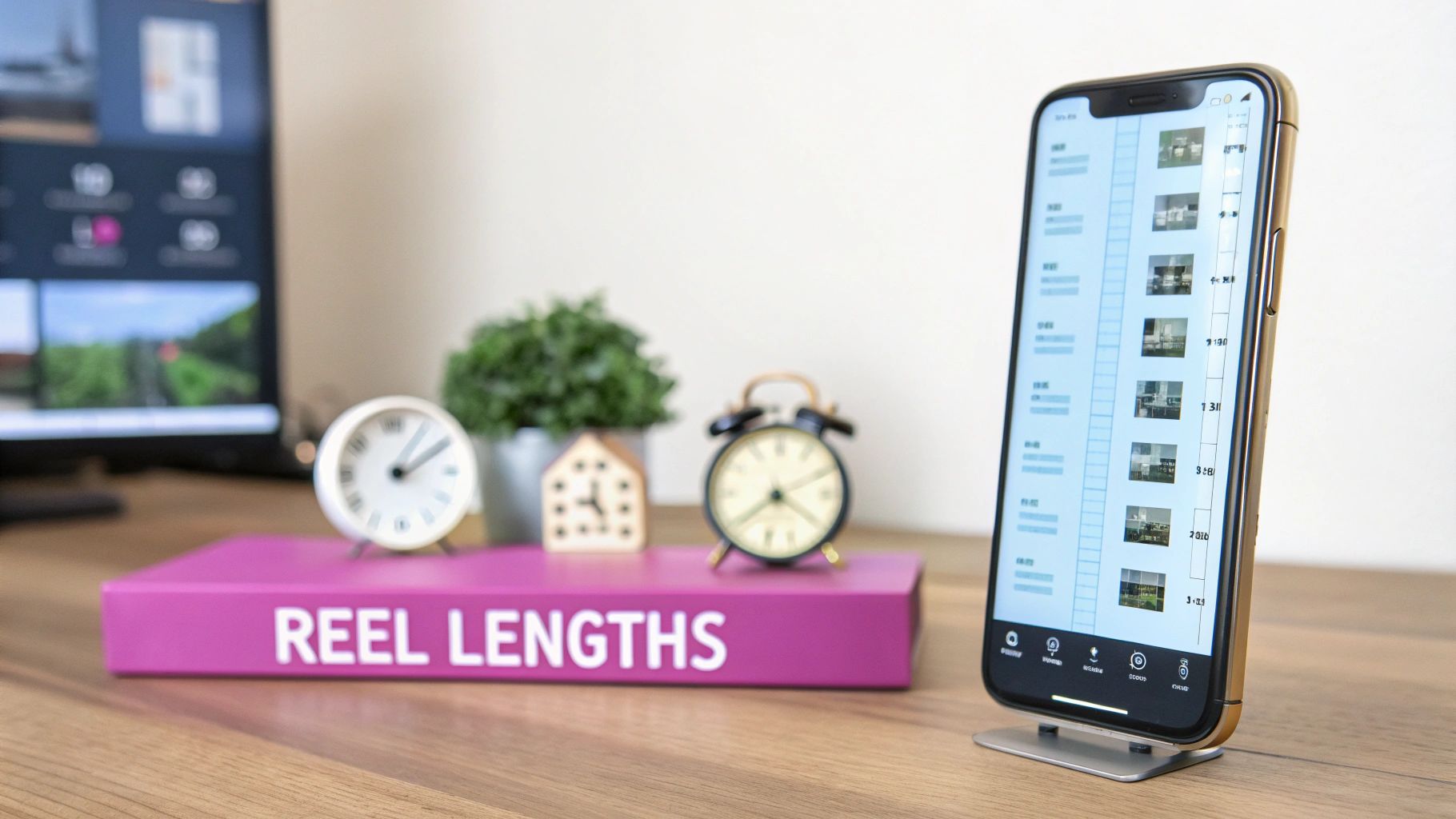
Instagram might give you a full three minutes to play with, but what works in practice is a whole different ballgame. The real secret to a Reel's success isn't just about how long Reels can be; it's about understanding how people actually behave when they’re endlessly scrolling. The truth is, shorter videos just fit our modern, fast-paced content habits better.
We all know attention spans are shrinking, and the Instagram algorithm is built with that in mind. One of the most important signals it looks for is completion rate—the percentage of people who watch your video all the way through. A high completion rate tells the algorithm your content is a hit, which means it gets shown to more people.
Think about it. It’s far easier for someone to finish a 15-second clip than it is to commit to a three-minute video. Viewers who stick around for a quick, punchy Reel directly boost your metrics, helping your content find a bigger audience.
Finding the Engagement Sweet Spot
So, what’s the magic number? While it’s not an exact science, research from across the industry points to a sweet spot for engagement somewhere between 15 and 30 seconds. This length gives you just enough time to land your message without losing your viewer’s interest.
In fact, one study found that Reels with an average length of 26 seconds received the most comments. It's powerful proof that less can be more. For a deeper dive into these numbers, you can explore the research on optimal Instagram Reels length.
This isn't just an Instagram thing, either. It’s a core principle of video marketing today, no matter the platform. If you're juggling content for different channels, our guide to creating short-form videos for TikTok and Reels has more tips that work everywhere.
The Psychology of the Scroll
When someone opens their Reels feed, they’re in a discovery mindset, making snap judgments—watch or swipe. Shorter videos are designed for this exact behavior by delivering an instant payoff.
The core principle is simple: deliver maximum value in minimum time. This approach respects the viewer's time and increases the likelihood of shares, comments, and saves—all signals that amplify your reach.
Let's look at a real-world example.
Practical Example: A Fitness Coach's Strategy
Imagine a fitness coach wants to share a new workout routine. They could post a detailed, three-minute Reel explaining every exercise from start to finish. But a much savvier move would be to create a high-energy, 20-second Reel that highlights just three key movements with quick cuts and a killer soundtrack.
This shorter format nails several key goals at once:
- Higher Completion Rate: Almost everyone who starts the 20-second clip will finish it.
- Increased Replays: The fast pace encourages viewers to watch it again to catch the details.
- Clear Call-to-Action: The coach can end with a simple "Save this for your next workout!"—an easy action that drives engagement way up.
At the end of the day, you want your content to feel like a great find, not a chore. By keeping your Reels concise, you're working with both the algorithm and your audience, which is the surest path to getting your content seen.
How Reel Length Compares Across Platforms
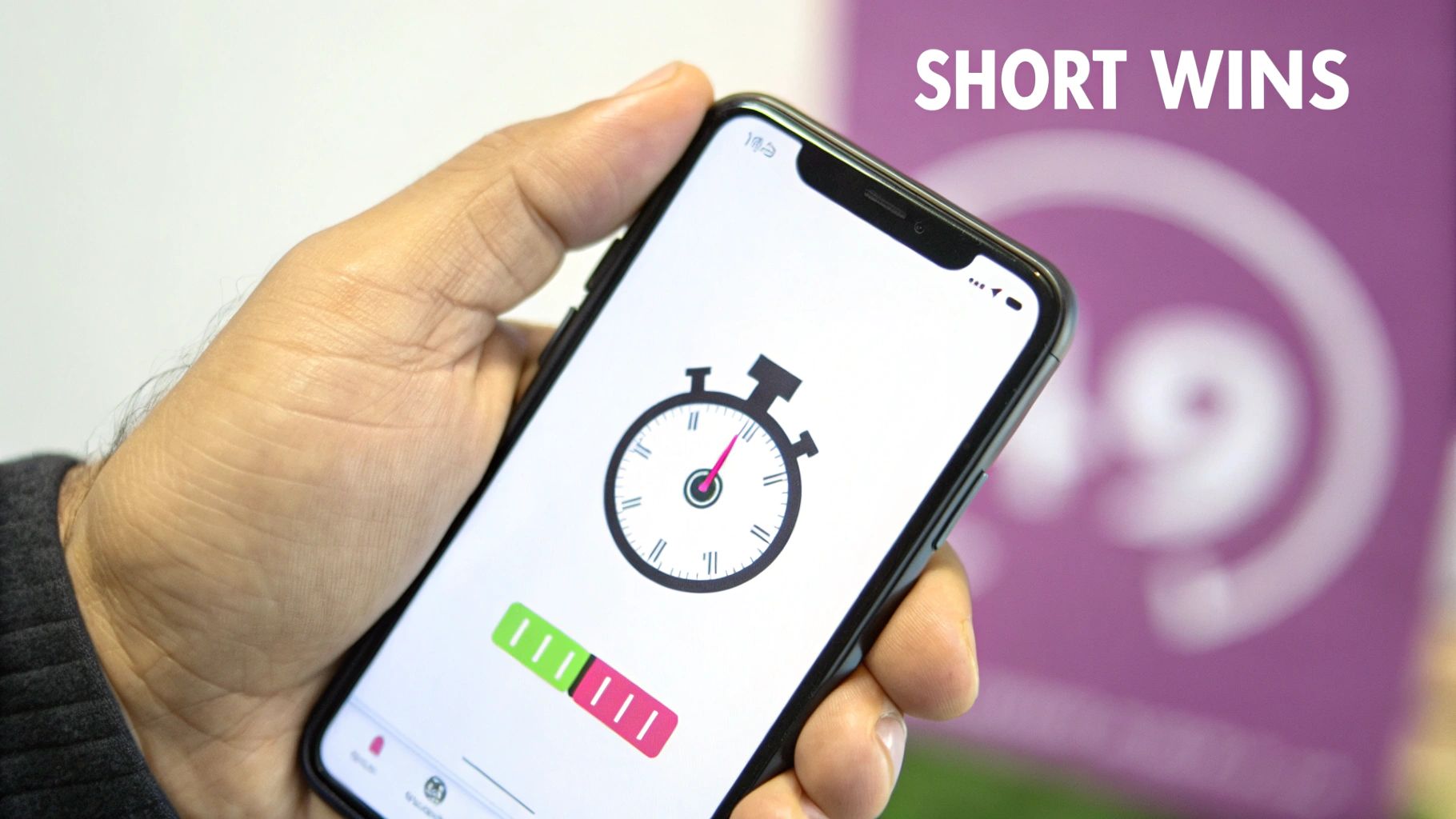
Knowing how long an Instagram Reel can be is a great start, but it's really only one piece of the puzzle. To build a winning content strategy, you have to look at the bigger picture—and that means understanding how Instagram stacks up against its biggest competitors, TikTok and YouTube Shorts.
Each platform has its own unwritten rules, audience expectations, and unique content culture. A one-size-fits-all approach to your video just won't cut it.
The time limits on these platforms are wildly different, and that directly shapes the kind of content that performs best. Instagram's 3-minute cap puts it right in the middle of the pack, giving you more room for storytelling than YouTube Shorts but keeping things more concise than TikTok's longer format. This isn't just a technical detail; it fundamentally changes how users watch and what creators make.
And the stakes are high. Over 2 billion users watch Reels every month, adding up to an incredible 140 billion daily views. That's a massive audience, so it pays to understand what works. You can dive deeper into the numbers behind Instagram Reel engagement to see just how competitive the space is.
Reels vs TikTok vs YouTube Shorts Length
To make things simple, let's break down the hard numbers and the practical realities of what actually works on each platform. The maximum time allowed is one thing, but the "sweet spot" where users stay hooked is often much shorter.
| Platform | Maximum Length | Optimal Engagement Length | Our Edge |
|---|---|---|---|
| Instagram Reels | 3 minutes | 15-45 seconds | Flexible enough for trends and tutorials. |
| TikTok | 10 minutes | 21-60 seconds | Ideal for deep dives and episodic content. |
| YouTube Shorts | 60 seconds | 15-59 seconds | Best for high-impact, rapid-fire clips. |
While TikTok offers a huge runway for longer videos, the core of all three platforms is still built on grabbing attention quickly. Your best bet is almost always to deliver value upfront and keep it tight.
What the Time Limits Really Mean
Let's unpack what these numbers tell us about each platform's personality.
-
Instagram Reels: With its 3-minute ceiling, Instagram gives you flexibility. You can create a quick, punchy clip that's built for viral trends, or you can stretch it out a bit for a mini-tutorial or a behind-the-scenes look. Even so, the algorithm still tends to favor content in that 15-45 second range.
-
TikTok: As the OG of short-form video, TikTok has expanded to allow uploads up to 10 minutes. This opens the door for much deeper storytelling, detailed commentary, and even episodic content. But don't be fooled—the "For You Page" is still dominated by snappy, highly engaging videos under a minute.
-
YouTube Shorts: YouTube keeps it simple with a strict 60-second maximum. The platform is designed for rapid-fire consumption, rewarding creators who get straight to the point with high-impact, easily digestible videos.
Think of it this way: a platform's time limit is a clue to its content philosophy. YouTube Shorts is all about brevity. TikTok is experimenting with longer, more immersive formats. And Instagram Reels is trying to be the best of both worlds.
Making Your Content Fit the Platform
A video that blows up on TikTok won't necessarily land the same way on Instagram. You have to tweak your approach for each audience and algorithm.
Practical Example: A DIY Home Decor Creator
Imagine a creator wants to share a cool furniture flip.
-
On YouTube Shorts, they might create a slick, 45-second montage. Think quick cuts, dramatic before-and-after shots, and a trending song to tie it all together. All impact, no fluff.
-
For Instagram Reels, they could use about 90 seconds to create a mini-tutorial. They'd show the three most important steps, add some text overlays, and end with a satisfying final reveal.
-
On TikTok, they have the space to go deep. They could post a 3-minute, voice-over-style guide that walks viewers through the entire process, from sanding and priming to the final coat of paint, even sharing a few mistakes to avoid.
Each version of the video serves a different purpose because it's built for the platform's specific time limits and what its users have come to expect. This is how you make sure your hard work actually gets seen.
How to Structure a Killer Reel, No Matter the Length
Whether you're creating a quick 15-second teaser or a more in-depth 90-second story, the secret to a great Reel isn't its length. It's all about the structure. The most effective Reels—the ones that actually make people stop scrolling—almost always follow a simple, repeatable three-part formula: the Hook, the Story, and the Call-to-Action (CTA).
Nailing this framework turns video creation from a game of chance into a reliable process. It’s your blueprint for making content that works, every single time.
Part 1: The Can't-Look-Away Hook
You have about three seconds. That's it. That's the window you have to convince someone to stop their endless scroll and watch your video. Your hook is everything. A weak hook means all the great content that follows will never even be seen.
The whole point is to trigger instant curiosity or hit an emotional nerve. A killer hook could be:
- A provocative question: "Are you making this huge mistake with your morning coffee?"
- A bold statement: "I grew my email list by 200% with one simple change."
- A visually stunning shot: Think of a dramatic before-and-after, a jaw-dropping landscape, or one of those oddly satisfying process shots.
Don't just take my word for it. Videos with a strong hook in the first three seconds retain 37% more viewers past the 10-second mark compared to those that just meander into the topic. It’s a make-or-break moment.
Part 2: The Gripping Story
Okay, you've got their attention. Now what? The middle of your Reel—the story—is where you deliver on the promise you made in the hook. This is the meat of your video, where you provide real value through education, entertainment, or a bit of inspiration. You have to keep the energy up with a clear narrative and snappy edits.
This is where you show your stuff. Use quick cuts, interesting camera angles, and on-screen text to keep your viewer's eyes glued to the screen. And please, don't forget that around 80% of social media videos are watched on mute. This makes clear, easy-to-read captions an absolute must. If you're looking for pointers, there are some fantastic ways to add subtitles to your short videos.
Think of the middle of your Reel as a mini-journey. You're taking the viewer from the problem you teased in the hook to a satisfying answer or resolution.
Part 3: The Clear Call-to-Action
You've hooked them and given them value. Now, what do you want them to do? A Reel without a CTA is like telling a great joke without a punchline—it just falls flat. Your CTA needs to be simple, direct, and tied directly to your goal for that video.
Practical Example: A Baker's Viral Reel
Imagine a local baker sharing a new cookie recipe. Here’s how they could break it down:
- The Hook (0-3 seconds): It starts with a glorious slow-motion shot of a warm, gooey chocolate chip cookie being pulled apart. Text on the screen reads: "You can throw away all your other cookie recipes."
- The Story (4-25 seconds): Next, a rapid-fire montage of the baking process. Quick shots of creaming butter and sugar, mixing in flour, folding in chocolate chips. Each key step gets a quick text label, all set to an upbeat, trending song.
- The CTA (26-30 seconds): The final shot is a plate piled high with perfect cookies. The caption asks: "Want the full recipe? Drop a 'COOKIE' emoji in the comments, and I'll DM it to you!"
This structure is airtight. The hook is pure visual temptation, the story is fast and valuable, and the CTA is an incredibly simple way to drive a ton of engagement. That's how you build the perfect Reel, every single time.
A Smarter Way to Create Your Reels
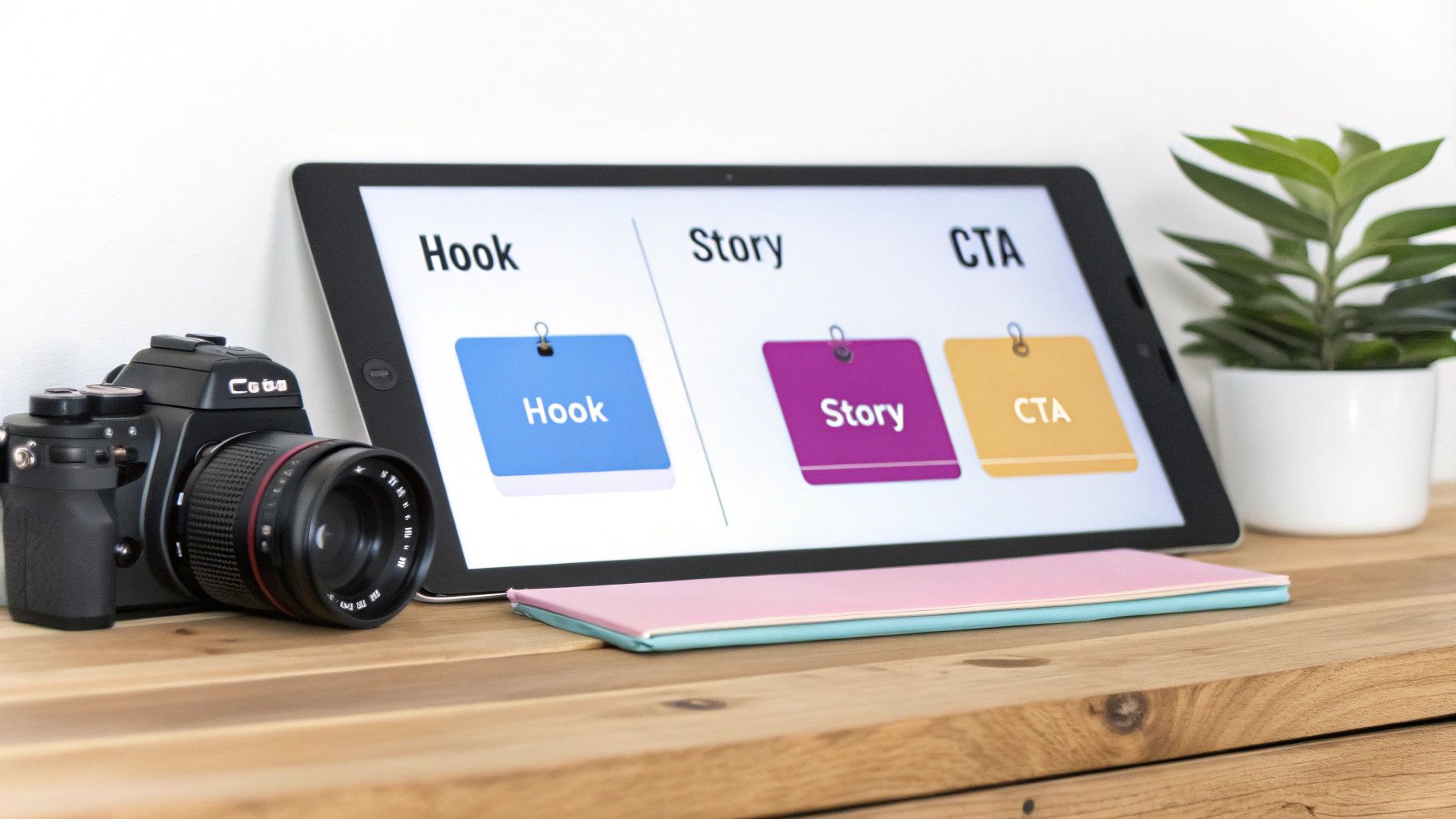
Let's be honest: churning out high-quality Reels that hit the right length and land with your audience can feel like a full-time job. If you're constantly scrambling to create something new every day, burnout is right around the corner. The secret isn't working harder; it's working smarter with an efficient workflow.
A game-changer for many creators is content batching. Instead of the daily scramble to film, edit, and post, you set aside a dedicated block of time—say, a few hours on a Monday morning—to knock out an entire week's worth of content. This shift is huge. It lets you get into a creative groove and frees you from the constant pressure of the content hamster wheel.
Plan It Out with a Content Calendar
Batching and planning go hand-in-hand. A content calendar is your strategic best friend here. It's more than just a schedule; it's a roadmap that helps you map out themes, keep an eye on what's working, and maintain a steady posting rhythm. The algorithm rewards consistency, and brands that stick to a regular schedule can see up to 30% higher engagement.
A solid content calendar should track a few key things:
- Post Dates and Times: Pinpoint when your audience is online and ready to engage.
- Topics and Themes: Tie your content to bigger goals, like an upcoming sale or a seasonal promotion.
- Reel Length and Style: Decide upfront if you're making a quick 15-second trend video or a more in-depth 60-second tutorial.
- Goals and CTAs: Know what you want each Reel to do. Is it about getting comments, driving traffic, or earning saves?
Repurpose Your Content Like a Pro
One of the best ways to keep that calendar full without starting from scratch every single time is to repurpose content you already have. Your long-form videos, webinars, podcast episodes, and even blog posts are basically a treasure chest of potential Reels.
Repurposing isn't about being lazy; it's about being strategic. It ensures your most valuable insights reach a wider audience in a format they love to consume.
Think about it: a 30-minute webinar is packed with insights. You could easily pull five or six powerful, bite-sized clips from it. Each one could highlight a key takeaway, a surprising stat, or a great customer story. This approach saves a ton of time and ensures you’ve always got a pipeline of valuable content. If you want a deep dive on how to do this quickly, our guide on how to repurpose long videos into engaging short clips with AI is a great place to start.
Practical Example: Turning a Podcast into Reels
Let’s say you have a marketing podcast. A single one-hour episode could easily become:
- A 30-second clip featuring a guest's most powerful quote.
- A 45-second animated Reel that brings a key statistic from the show to life.
- A 60-second how-to Reel that walks through a practical tip you discussed.
This strategy gets the most mileage out of the hard work you’ve already done. It keeps your feed fresh, your audience engaged, and gives you more time to focus on the big picture.
Your Top Questions About Reel Length, Answered
https://www.youtube.com/embed/ejWEq6auNP8
Even with the best strategy in place, you're bound to have some nitty-gritty questions about how long your Reels can actually be. Let's clear up the confusion so you can build your content plan with total confidence.
Can a Reel Be Longer Than 90 Seconds?
No, but it can be longer than 90 seconds. The absolute maximum for a single Instagram Reel is currently three minutes (180 seconds). Instagram has bumped this limit up over the years, but for now, that's the ceiling. If you try to upload something longer, the app will make you trim it down before you can post.
What Should I Do If My Video Is Too Long?
Don't throw away that great footage just because it's over the three-minute mark! You've got a few solid options to make it work.
Here are a few strategies I've seen work time and time again:
- Make it a series. Chop your longer video into a few bite-sized parts. This is a brilliant way to build a little suspense and get people coming back for more.
- Post a teaser. Grab the best 60-second chunk of your video to use as a Reel, then point everyone to the full-length version on a platform like YouTube.
- Speed it up. If you're showing a tutorial or some kind of process, speeding up the video can cram a lot of action into a short, dynamic clip that easily fits within the time limit.
Does Reel Length Actually Affect My Reach?
Absolutely. But it’s not as simple as "longer is better" or "shorter is better." The Instagram algorithm is obsessed with viewer retention and completion rates. Think about it—someone is way more likely to watch a whole 20-second video than they are to stick around for a full three minutes.
When more people watch your Reel to the end, it sends a powerful signal to the algorithm that your content is a hit. This often results in Instagram showing it to a much wider audience, which is why punchy, shorter Reels frequently get more reach than longer ones.
What’s the Best Reel Length for Getting Comments?
If you're trying to spark a conversation, aim for that sweet spot between 20 and 45 seconds. This gives you just enough time to ask a great question or share a relatable story that gets people itching to chime in.
Practical Example: Sparking Engagement
A travel creator could share a 30-second clip of a little-known cafe in Paris. The video could end with a simple question: "What's the most underrated spot you've ever visited? Drop it in the comments!" It’s a direct, easy-to-answer prompt wrapped in a quick video, which is the perfect recipe for engagement.
At the end of the day, the perfect length always comes back to your goal, but these guidelines should give you a much clearer idea of where to start.
Ready to turn your long videos into perfectly-timed, engaging Reels without all the manual guesswork? Swiftia uses AI to find the best moments in your content and transforms them into shareable clips in minutes. Start creating faster at swiftia.io.

